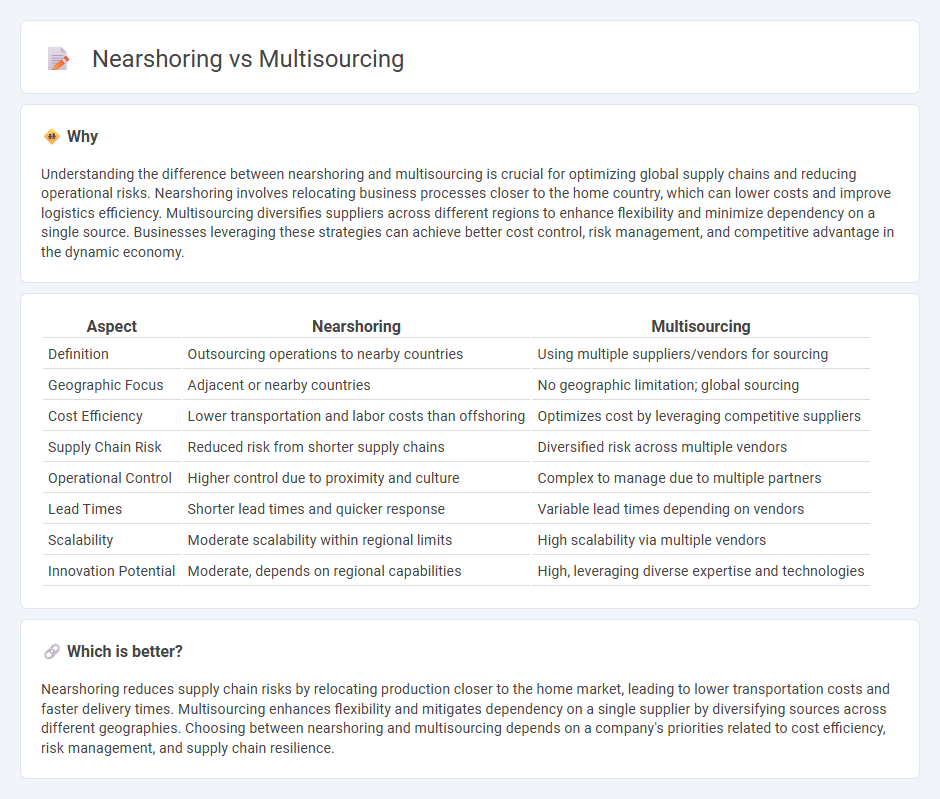
Nearshoring reduces supply chain risks by relocating production closer to the end market, enhancing agility and lowering transportation costs. Multisourcing diversifies risk through multiple suppliers across various regions, improving resilience against disruptions. Explore how these strategies can optimize operational efficiency and global competitiveness.
Why it is important
Understanding the difference between nearshoring and multisourcing is crucial for optimizing global supply chains and reducing operational risks. Nearshoring involves relocating business processes closer to the home country, which can lower costs and improve logistics efficiency. Multisourcing diversifies suppliers across different regions to enhance flexibility and minimize dependency on a single source. Businesses leveraging these strategies can achieve better cost control, risk management, and competitive advantage in the dynamic economy.
Comparison Table
| Aspect | Nearshoring | Multisourcing |
|---|---|---|
| Definition | Outsourcing operations to nearby countries | Using multiple suppliers/vendors for sourcing |
| Geographic Focus | Adjacent or nearby countries | No geographic limitation; global sourcing |
| Cost Efficiency | Lower transportation and labor costs than offshoring | Optimizes cost by leveraging competitive suppliers |
| Supply Chain Risk | Reduced risk from shorter supply chains | Diversified risk across multiple vendors |
| Operational Control | Higher control due to proximity and culture | Complex to manage due to multiple partners |
| Lead Times | Shorter lead times and quicker response | Variable lead times depending on vendors |
| Scalability | Moderate scalability within regional limits | High scalability via multiple vendors |
| Innovation Potential | Moderate, depends on regional capabilities | High, leveraging diverse expertise and technologies |
Which is better?
Nearshoring reduces supply chain risks by relocating production closer to the home market, leading to lower transportation costs and faster delivery times. Multisourcing enhances flexibility and mitigates dependency on a single supplier by diversifying sources across different geographies. Choosing between nearshoring and multisourcing depends on a company's priorities related to cost efficiency, risk management, and supply chain resilience.
Connection
Nearshoring reduces supply chain risks by relocating production closer to end markets, enhancing responsiveness and cost efficiency for multinational corporations. Multisourcing complements this strategy by diversifying suppliers across multiple nearshore locations, minimizing dependency on a single source and increasing flexibility. Together, nearshoring and multisourcing optimize supply chain resilience and operational agility in global economy contexts.
Key Terms
Cost Efficiency
Multisourcing leverages multiple vendors across various regions to reduce risks and drive competitive pricing, often resulting in cost savings through specialized service providers. Nearshoring cuts expenses related to logistics, time zones, and cultural differences by selecting geographically closer countries, enhancing operational efficiency and lowering overhead costs. Explore how these strategies impact your business's cost efficiency and optimization potential.
Vendor Diversification
Vendor diversification enhances risk management by spreading sourcing across multiple providers, reducing dependency on a single supplier common in nearshoring. Multisourcing leverages a variety of vendors, often across different regions, to optimize cost, innovation, and service quality. Explore detailed strategies to balance vendor diversification and operational efficiency in global sourcing models.
Geographic Proximity
Multisourcing involves contracting multiple vendors across diverse locations to optimize resources and expertise, while nearshoring prioritizes geographic proximity by outsourcing to nearby countries to reduce time zones, cultural barriers, and shipping costs. Geographic proximity in nearshoring enhances communication efficiency and project agility, making it ideal for businesses needing faster turnaround times. Discover how leveraging the right sourcing strategy can transform your supply chain and operational efficiency.
Source and External Links
What is multisourcing? | Outsource Accelerator - Multisourcing involves outsourcing to multiple service providers to meet rising business demands, enhancing operational efficiency and reducing vendor risks.
Multisourcing - Wikipedia - Multisourcing is the practice of working with multiple suppliers who are also competitors to ensure a stable supply and reduce reliance on a single vendor.
Multi-Sourcing: Everything You Need To Know | SupplierGateway - Multisourcing is an outsourcing approach where products or services are contracted to various suppliers to enhance flexibility and mitigate supply disruptions.
 dowidth.com
dowidth.com